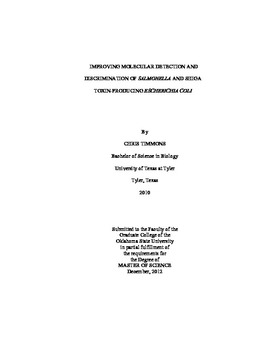| dc.description.abstract | Foodborne illnesses caused by non-O157 Shiga toxin-producing Escherichia coli (STEC) and Salmonella enterica (SE) are significant health concerns and economic burdens worldwide. While SE is an established pathogen, causing more illnesses, hospitalizations, and deaths in the United States than any other foodborne bacterial pathogen, non-O157 STEC are emerging pathogens of growing concern. Multistate and multinational outbreaks of foodborne illness are frequently associated with SE and non-O157 STEC contaminated food. Effective surveillance of foodborne illnesses and investigations of foodborne illness outbreaks rely on rapid, robust, and sensitive methods for pathogen detection and strain discrimination. The objectives of this research were 1) to evaluate the effect on PCR sensitivity of adding a short, AT-rich overhanging nucleotide sequence (flap) to the 5' end of PCR primers specific for the detection of Salmonella and E. coli O157:H7 and 2) to develop a multiple-locus variable-number tandem repeat (VNTR) analysis (MLVA) method for strain discrimination of 6 major serogroups of non-O157 STEC. When targeting individual pathogens, end-point PCR assays using flap-amended primers were more efficient than non-amended primers, with 20.4% and 23.5% increases in amplicon yield for Salmonella and E. coli O157:H7, respectively. In multiplex PCR assays, a 10- to 100-fold increase in detection sensitivity was observed when the primer flap sequence was incorporated. The MLVA method developed for non-O157 STEC used 12 VNTR loci that were amplified in 3 multiplex PCR reactions and sized by multicolor capillary electrophoresis. All serogroups were differentiable by the method, as 4 of the 6 serogroups were clustered separately in a minimum spanning tree. The developed MLVA method was more discriminatory for serogroups O26, O111, O103, and O121 than it was for O45 and O145. Compared to pulsed-field gel electrophoresis (PFGE), the "gold standard" bacterial pathogen subtyping technique, the MLVA method exhibited higher discriminatory power for serogroup O26, a similar level of discrimination for serogroups O111, O103, and O121, and a lower level of discrimination for serogroups O45 and O145. The methods developed in this research have potential applications in the food and agricultural industries, foodborne outbreak surveillance and investigations, and biosecurity and microbial forensics. | |
